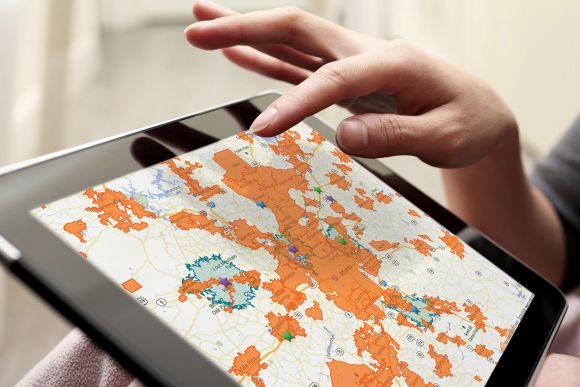It’s classic business wisdom: when defining your strategies and tactics, you need to understand the competitive environment. No business operates in a vacuum. That’s why you need to ask yourself – What are your competitors already doing, and how will your strategies compare to theirs?
Traditional methods of competitive monitoring vary widely. Monitoring news about your competitors, keeping up with financial earnings reports, paying attention to their marketing campaigns and offers, tracking where they have opened and closed locations, and subscribing to industry data sources for insights into industry-level performance and benchmarks are all helpful tactics that rely on publicly available information.
Today, retailers, restaurants, and consumer service brands have an additional tool at their disposal for understanding the dynamics of their competitors’ businesses: location intelligence that leverages foot traffic analytics. We’ll dive into the benefits of location intelligence and how it works.
Why Location Intelligence Is Important
Location intelligence is a powerful tool for competitive monitoring, providing deeper insights that go beyond traditional competitive intelligence techniques. It allows businesses to track market trends in real time, compare performance against competitors, and identify opportunities before the competition even realizes they exist. With location intelligence, you can uncover critical insights like which types of consumers favor your competitors, how their customer profile compares to yours, and whether your trade areas overlap—all in a fraction of the time of traditional methods.
Get Answers Faster
Keeping a pulse on your competitors requires more than periodic market reports or anecdotal insights. Location intelligence enables businesses to access real-time foot traffic analytics and customer data, providing a faster, more accurate picture of competitor performance. Unlike traditional competitive intelligence techniques, which can be slow and reactive, location intelligence allows you to proactively monitor changing conditions and make timely decisions to stay ahead.
Compare Your Brand to Competitors
Competitive intelligence isn’t just about tracking where your competitors are—it’s about understanding how they operate and who they attract. Location intelligence allows for quick, data-driven comparisons between your brand and competitors, answering key questions like: Are they attracting the same customer segments as you? Are they outperforming you in shared trade areas? Where do your markets overlap, and where do new opportunities exist? These insights help refine your strategy and uncover ways to gain an edge.
Anticipate Market Shifts
With location intelligence, you can gain visibility into what’s happening at competitor locations long before earnings reports or industry news reveal it. By tracking foot traffic trends, trade area dynamics, and consumer behavior shifts, businesses can anticipate competitor moves, adjust their own strategies, and capitalize on market changes before others do.
Optimize Your Growth Strategy
Location intelligence ensures that your business decisions aren’t just based on instinct but backed by real-world data. By understanding consumer preferences, trade area strengths, and competitor positioning, businesses can expand smarter, optimize existing locations, and avoid costly mistakes.
In today’s fast-moving market, staying ahead means having access to the right insights at the right time. Location intelligence provides that advantage—helping businesses not only keep up with competitors but outmaneuver them.
Using Location Analytics to Understand a Competitor’s Business
With foot traffic analytics, a type of location intelligence, you can gather intelligence on the typical consumer profiles of visitors to a selected study area. It works by analyzing aggregated and anonymized signals from mobile devices to identify movement patterns and visitation trends across geographic locations. This data provides insights into foot traffic volumes, dwell times, and visitor demographics/psychographics, offering a comprehensive picture of how consumers interact with specific areas.
Many brands have started using foot traffic analytics as a tool for monitoring their own locations or analyzing properties where they are considering opening a new location, but these tools can also be used to better understand the dynamics at a competitor’s locations.
For example, foot traffic analytics can help you address questions such as the following:
- What is the volume trend at my competitors’ locations? If your competitor doesn’t publicly release traffic and earnings information, this can be a helpful way to understand how their business is likely performing. If your competitor does release this type of information, you can use the analytics to keep up with trends before earnings announcements.
- Do my competitors experience the same type of seasonality in visits that I experience? You may assume that all competitors experience the same type of seasonal patterns as your business, but is that true? Study the traffic patterns over time and compare them against your own. If a competitor seems to be defying the odds and maintaining traffic levels during traditionally off-peak times, that’s a signal that you may need to study their marketing, product offerings, or consumer base in more detail.
- Are my competitors attracting the same types of consumers that I want to attract? Consumers are attracted to certain brands based on their lifestyles and the brand’s fit with that lifestyle. Which types of consumers are visiting your competitors’ locations? Are they the same type of consumers you are trying to reach or a different consumer base entirely?
Related: Your Guide to Location-Based Analytics
Location Intelligence Use Cases for Competitive Intelligence
By leveraging Buxton’s analytics and tools like SCOUT and Mobilytics, organizations across industries can gain a strategic edge by using location intelligence to monitor competitors, refine real estate decisions, and improve targeted marketing efforts. Here’s how businesses can apply location intelligence to strengthen their competitive intelligence strategies:
Strategy: Define Competitive Intensity
Understanding your competitive landscape is key to making informed business decisions. Location intelligence allows you to analyze whether you and your competitors are attracting the same types of customers, helping you assess your competitive position. By visualizing trade area overlap, businesses can identify markets where competition is fierce and areas where untapped opportunities exist. These insights help refine market strategies and identify where to focus resources for expansion or defensive positioning.
Real Estate: Add Competitive Context to Site Selection
Selecting the right location requires more than just evaluating consumer demand—you need to understand the competitive environment. Location intelligence enables businesses to assess potential site trade areas relative to competitors' observed trade areas. This competitive context helps businesses avoid oversaturation, strategically position new locations, and optimize market coverage while minimizing cannibalization.
Marketing: Target Competitor Audiences More Effectively
Location intelligence enhances marketing strategies by helping businesses identify and engage competitor audiences. By analyzing competitor customer profiles, businesses can pinpoint priority consumer segments and geographic areas for targeted advertising. Whether it’s launching promotions in key trade areas or refining digital marketing efforts to attract competitor customers, location intelligence ensures marketing resources are deployed where they’ll have the greatest impact.
Location Analytics Options
If you are ready to begin using location intelligence to better understand the consumer dynamics at your competitors’ locations, it’s important to understand that there are several ways to approach this analysis.
On-Demand Tools
For many brands, an on-demand tool is a great option. It gives you the ability to refresh the analysis as often as you want. There’s a lot of variety in the types of tools available. Some tools allow you to benchmark traffic volumes for an entire industry or brand. Meanwhile, some allow you to dive deeper by location, and some include the ability to define custom study areas rather than pre-set areas. The level of consumer information available will depend on what other types of datasets are included in the system.
Analytics Enrichments for Location Intelligence Software
Some analytics providers offer data and analytics enhancements for their location intelligence platform that come with pre-processed competitive insights. For example, you may be able to access map layers with a competitors’ observed visitors, customer profiles, and store trade areas. You might also be able to subscribe to reports that summarize relevant statistics about your competitors’ observed customers relative to your own observed customers.
A note: since this analysis is based on aggregated and deidentified mobile device data, it isn’t a perfect fit for every type of business. For example, it’s tough to differentiate between mobile device signals coming from different levels of the same building, so if your competitor primarily operates in malls or highly dense urban areas, you may need to consider other options. Still, for many brands, this form of location intelligence offers unique insights not previously available.
Related: Benefit from the Best Location Intelligence Software
The Bottom Line
Keeping up with your competitors empowers your leadership team to make smart strategic decisions. Foot traffic analytics combined with location intelligence software can provide an additional layer of insights to complement traditional competitive monitoring techniques.
Intrigued? Buxton offers several location intelligence solutions to meet your needs.
Contact us to discuss the option that’s right for you.


